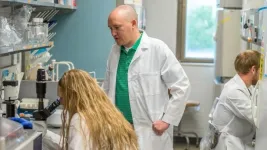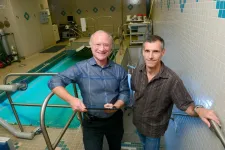(Press-News.org) Dwindling water supplies and a growing population will halve per capita water use in Jordan by the end of this century. Without intervention, few households in the arid nation will have access to even 40 liters (10.5 gallons) of piped water per person per day.
Low-income neighborhoods will be the hardest hit, with 91 percent of households receiving less than 40 liters daily for 11 consecutive months per year by 2100.
Those are among the sobering predictions of a peer-reviewed paper by an international team of 17 researchers published March 29 in Proceedings of the National Academy of Sciences.
Jordan's deepening water crisis offers a glimpse of challenges that loom elsewhere as a result of climate change, population growth, intensifying water use, demographic shocks and heightened competition for water across boundaries, said study co-author and Stanford hydrologist Steve Gorelick, who directs the Global Freshwater Initiative at Stanford's Woods Institute for the Environment. The World Health Organization estimates half of humanity may live in water-stressed areas by 2025, and the United Nations anticipates water scarcity could displace 700 million people by 2030.
In Jordan, flows in the region's biggest river system - the Jordan-Yarmouk - have declined as a result of upstream diversion in Israel and Syria. Groundwater levels in some areas have dropped by more than 1 meter per year, and a major aquifer along Jordan's boundary with Saudi Arabia is heavily pumped on both sides of the border.
Demand for water has climbed largely because of population growth punctuated by waves of refugees, including more than 1 million Syrian refugees in the past decade.
Extreme water scarcity and wide disparities in public water supplies are potent ingredients for conflict. Jordan's water situation - long deemed a crisis - is now on the brink of "boiling over" into instability, said lead study author Jim Yoon, a water security and resilience scientist at Pacific Northwest National Laboratory.
"Jordan's unique role as a bastion of peace in the region makes these findings all the more cause for concern," said Yoon, who began work on the study as a PhD student at Stanford University.
The U.N. has committed to ensuring sustainable freshwater management and universal access to clean water and sanitation as one of its 17 sustainable development goals. But until now, analytic frameworks have been lacking, said Gorelick, who led the Jordan Water Project and its continuation, the FUSE Project (Food-water-energy for Urban Sustainable Environments).
The new predictions derive from a first-of-its-kind computer model of Jordan's freshwater system that simulates interactions among natural processes and human behaviors. Under a range of climate and socioeconomic scenarios, the researchers quantified the effects of maintaining status quo versus introducing measures such as fixing leaky pipes, eliminating water theft, raising tariffs for big water users and reallocating a quarter of water from farms to cities.
The team's modeling suggests efforts to simultaneously increase supply, slash demand and reform distribution are likely to deliver "exponential" improvements in national water security.
Access to Jordan's public water supply today is highly unequal, with wealthier households and firms often supplementing rationed municipal supplies with costly deliveries from private tanker truck operators. German economist and study co-author Christian Klassert said, "Avoiding large disparities in public water supply will be necessary to avoid water stress under growing water scarcity in Jordan and regions around the world."
The many facets of Jordan's water crisis make it an especially valuable place to explore the impacts of individual versus simultaneous interventions, Gorelick said. Now that a model exists for this complex environment, it can be adapted with relative ease to other regions.
The single most effective step Jordan can take is to increase supply through large-scale desalination. One proposal among many Jordan has pursued to this end since the 1960s would desalinate water from the Red Sea in the south, transport freshwater north to the capital city Amman and dispose of the leftover highly saline water in the rapidly shrinking Dead Sea.
While water policy debates often present selected supply and demand interventions as opposing alternatives, the authors write, suites of interventions in both modes actually work best in concert.
"You would think that any one of these interventions would have a greater impact. But it turns out you have to do everything," Gorelick said.
For a country whose economic output per person is less than one-tenth that of the U.S., the scale and cost of near-total reform of its water sector are particularly daunting. "In water-scarce regions where sustainability planning is most needed, it is challenging to think beyond how to distribute scarce freshwater tomorrow, next month, and to some extent, in the next several years," Gorelick said. "It's in these places where our long-term policy evaluations are most valuable."
INFORMATION:
Read a blog post by Gorelick, Klassert and Yoon highlighting key points for policymakers.
Watch a 4-minute video about the research.
Gorelick is the Cyrus Fisher Tolman Professor at Stanford's School of Earth, Energy & Environmental Sciences (Stanford Earth). Additional co-authors on the paper, titled "A coupled human-natural system analysis of freshwater security under climate and population change," are affiliated with the Helmholtz Centre for Environmental Research - UFZ; University of Manchester; Université Laval; King's College London; Jordan University of Science and Technology; Leipzig University; University of California, Merced; Bechtel Corporation; and Texas A&M University.
The work was funded by the National Science Foundation and the UK's Natural Environment Research Council (NERC), Germany's Deutsche Forschungsgemeinschaft and the German Federal Ministry of Education and Research as part of the Belmont Forum. Stanford's Woods Institute for the Environment and USAID provided additional funding.
Materials such as gallium arsenide are extremely important for the production of electronic devices. As supplies of it are limited, or they can present health and environmental hazards, specialists are looking for alternative materials. So-called conjugated polymers are candidates. These organic macromolecules have semi-conductor properties, i.e. they can conduct electricity under certain conditions. One possible way of producing them in the desired two-dimensional - i.e. extremely flat - form is presented by surface chemistry, a field of research established in 2007.
Since then, many reactions have been developed and interesting materials produced for possible applications. ...
When humans look out at a visual landscape like a sunset or a beautiful overlook, we experience something -- we have a conscious awareness of what that scene looks like. This awareness of the visual world around us is central to our everyday existence, but are humans the only species that experiences the world consciously? Or do other non-human animals have the same sort of conscious experience we do?
Scientists and philosophers have asked versions of this question for millennia, yet finding answers -- or even appropriate ways to ask the question -- has proved elusive. But a team of Yale researchers recently devised an ingenious way to try to solve ...
One specific protein may be a master regulator for changing how cancer cells consume nutrients from their environments, preventing cell death and increasing the likelihood the cancer could spread, a study from the University of Notre Dame has shown.
The study, published in Cell Reports, was completed in the laboratory of Zachary Schafer, the Coleman Foundation Associate Professor of Cancer Biology in the Department of Biological Sciences.
Schafer and collaborators found a protein called SGK1, known to be activated in a variety of cancer cell types, signals the ...
LOS ALAMOS, N.M., March 29, 2021--A first-of-its-kind instrument that samples smoke from megafires and scans humidity will help researchers better understand the scale and long-term impact of fires--specifically how far and high the smoke will travel; when and where it will rain; and whether the wet smoke will warm the climate by absorbing sunlight.
"Smoke containing soot and other toxic particles from megafires can travel thousands of kilometers at high altitudes where winds are fast and air is dry," said Manvendra Dubey, a Los Alamos National Laboratory atmospheric scientist and co-author on a paper published last week in Aerosol Science and Technology. "These smoke-filled clouds can absorb ...
Among patients who return to work after a heart attack, those who work more than 55 hours per week, compared to those working an average full-time job of 35-40 hours a week, increase their odds of having a second heart attack by about twofold, according to a prospective cohort study published today in the Journal of the American College of Cardiology.
Data from the International Labour Office estimates 1 in 5 workers worldwide work over 48 hours per week. Previous studies have found an association between working long hours and increased risk of coronary heart disease and stroke. This is the first study of its kind to examine the effect of long working hours and the risk of a second cardiovascular event ...
Firearm injuries are a leading and preventable cause of injury and death among youth - responsible for an estimated 5,000 deaths and 22,000 non-fatal injury hospital visits each year in American kids. And while hospital systems are poised to tackle this issue using a public health approach, prevention efforts and policies may be differentially effective. A new study led by researchers at Children's National Hospital, finds that sociodemographic factors related to intent of injury by firearm may be useful in guiding policy and informing tailored interventions for the prevention of firearm injuries in at-risk youth.
"We sought to explore differences by injury intent in a ...
DALLAS - March. 29, 2021 - With NASA preparing to send humans to Mars in the 2030s, researchers are studying the physical effects of spending long periods in space. Now a new study by scientists at UT Southwestern shows that the heart of an astronaut who spent nearly a year aboard the International Space Station shrank, even with regular exercise, although it continued to function well.
The results were comparable with what the researchers found in a long-distance swimmer who spent nearly half a year trying to cross the Pacific Ocean.
The study, published today in Circulation, reports that astronaut Scott Kelly, now retired, lost an average of 0.74 grams - about three-tenths of an ounce - per week in the mass ...
Although the development of secondary cancerous growths, called metastasis, is the primary cause of death in most cancers, the cellular changes that drive it are poorly understood. In a new study, published in Genome Biology, researchers at the University of Illinois Urbana-Champaign have developed a new modeling approach to better understand how tumors become aggressive.
"Researchers have identified several cellular pathways that change when a tumor becomes aggressive. However, it is difficult to understand how they affect the tumor," said Steven Offer, an assistant professor of molecular pharmacology and experimental therapeutics at Mayo Clinic, Minnesota. "We wanted to develop a simple system that can model how cancer cells form ...
FINDINGS
A new study by researchers at the UCLA Jonsson Comprehensive Cancer Center found using percutaneous image guided needle based thermal ablation -- the precise application of extreme heat or cold to a tumor using sophisticated ultrasound, CT or MRI in a single outpatient session -- is a safe and effective adjunctive therapy for the local control of metastatic gynecologic cancers throughout lungs, liver, soft tissues in the abdomen and pelvis and bones in patients with advanced localized cancers unresponsive to systemic therapy.
Nearly 96% of the patients in the study achieved a complete tumor response over a median follow up period of 10 months. The overall survival rate was 37.5 months and the progression-free ...
BOSTON - In the last 20 years, Black adults living in rural areas of the United States have experienced high mortality rates due to diabetes, high blood pressure, heart disease and stroke compared to white adults. In a research letter written by colleagues at Beth Israel Deaconess Medical Center (BIDMC) and published in the END ...



